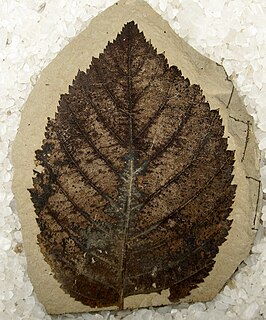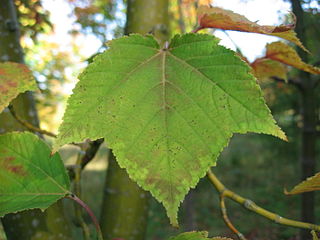
Paleobotany, which is also spelled as palaeobotany, is the branch of botany dealing with the recovery and identification of plant remains from geological contexts, and their use for the biological reconstruction of past environments (paleogeography), and the evolutionary history of plants, with a bearing upon the evolution of life in general. A synonym is paleophytology. It is a component of paleontology and paleobiology. The prefix palaeo- means "ancient, old", and is derived from the Greek adjective παλαιός, palaios. Paleobotany includes the study of terrestrial plant fossils, as well as the study of prehistoric marine photoautotrophs, such as photosynthetic algae, seaweeds or kelp. A closely related field is palynology, which is the study of fossilized and extant spores and pollen.

Nelumbo is a genus of aquatic plants with large, showy flowers. Members are commonly called lotus, though the name is also applied to various other plants and plant groups, including the unrelated genus Lotus. Members outwardly resemble those in the family Nymphaeaceae, but Nelumbo is actually very distant to that family.

Peltandra, the arrow arums, is a genus of plants in the family Araceae. It is native to the eastern United States, eastern Canada, and Cuba.
- Peltandra sagittifolia - (Michx.) Morong - Spoon flower or the white arrow arum - southeastern US from eastern Louisiana to Virginia
- Peltandra virginica(L.) Schott - Arum arrow - Cuba, Quebec, Ontario, Oregon, California, Washington; eastern US from Maine to Florida, west to Texas, Kansas, and Minnesota
- †Peltandra primaeva – Eocene, Golden Valley Formation, North Dakota, USA
Pinus peregrinus is an extinct species of pine in the family Pinaceae known from Clarkforkian age Paleocene fossils found in western North Dakota, USA.
Peltandra primaeva is an extinct species of monocot in the family Araceae known from a Ypresian age Eocene fossil found in western North Dakota, USA.
Acer douglasense is an extinct maple species in the family Sapindaceae described from fossil leaves. The species is solely known from the Early Eocene sediments exposed in Katmai National Park and Preserve, Kodiak Island Borough, Alaska. It is the type species for the extinct section Douglasa.
Acer alaskense is an extinct maple species in the family Sapindaceae described from a fossil leaf. The species is solely known from the Latest Paleocene sediments exposed in the Matanuska River Valley, Matanuska-Susitna Borough, Alaska. It is the type species for the extinct section Alaskana.
Acer washingtonense is an extinct maple species in the family Sapindaceae described from one fossil leaf and four fossil samaras. The species is solely known from the Early Eocene sediments exposed in northeast Washington state, United States. It is one of three species belonging to the extinct section Torada.
Acer stewarti is an extinct maple species in the family Sapindaceae described from a series of fossil leaves and samaras. The species is solely known from the Early Eocene sediments exposed in south central British Columbia, Canada adjacent to northeast Washington state, United States. It is one of only two species belonging to the extinct section Stewarta.
Acer browni is an extinct maple species in the family Sapindaceae described from a series of isolated fossil leaves and samaras. The species is known from the early to middle Miocene sediments exposed in Western Oregon, Washington state, USA and Northern Graham Island, Haida Gwaii, Canada. It is one of several extinct species placed in the living section Parviflora.
Acer dettermani is an extinct maple species in the family Sapindaceae described from a series of isolated fossil leaves. The species is known from the late Eocene to early Oligocene sediments exposed in the state of Alaska, USA. It is one of several extinct species placed in the living section Macrantha.

Acer latahense is an extinct maple species in the family Sapindaceae described from series of isolated fossil leaves. The species is known from the latest early to middle Miocene sediments exposed in the states of Oregon and Washington, USA. It is one of several extinct species placed in the living section Macrantha.
The Golden Valley Formation is a stratigraphic unit of Late Paleocene to Early Eocene age in the Williston Basin of North Dakota. It is present in western North Dakota and was named for the city of Golden Valley by W.E. Benson and W.M. Laird in 1947. It preserves significant assemblages of fossil plants and vertebrates, as well as mollusk and insect fossils.

Acer chaneyi is an extinct maple species in the family Sapindaceae described from a number of fossil leaves and samaras. The species is known from Oligocene to Miocene sediments exposed in Alaska, Idaho, Nevada, Oregon and Washington in the U.S. It is one of several extinct species belonging to the living section Rubra.

Glyptostrobus europaeus is an extinct conifer species of the family Cupressaceae that is found as fossils throughout the Northern Hemisphere. The sole living species of Glyptostrobus was described from China in 1926. The name of the genus comes from the Greek "glypto" meaning grooved or carved, and "strobilus" meaning cone. The species name "europaeus" refers to the fact that it was first described from Europe.

Tsukada is an extinct genus of flowering plant in the family Nyssaceae related to the modern "dove-tree", Davidia involucrata, containing the single species Tsukada davidiifolia. The genus is known from fossil leaves found in the early Eocene deposits of northern Washington state, United States and a similar aged formation in British Columbia, Canada.

Ulmus okanaganensis is an extinct species of flowering plant in the family Ulmaceae related to the modern elms. The species is known from fossil leaves, flowers, and fruits found in the early Eocene deposits of northern Washington state, United States and similar aged formations in British Columbia, Canada.
Paraconcavistylon is an extinct genus of flowering plant in the family Trochodendraceae comprises a single species, Paraconcavistylon wehrii. The genus is known from fossil fruits and leaves found in the early Eocene deposits of northern Washington state, United States, and southern British Columbia, Canada. The species was initially described as a member of the related extinct genus Concavistylon as "Concavistylon" wehrii, but subsequently moved to the new genus Paraconcavistylon in 2020 after additional study.

Barghoornia is an extinct genus of flowering plants in the family Burseraceae containing the solitary species Barghoornia oblongifolia. The species is known from fossil leaves found in the early Eocene deposits of northern Washington state, United States.

Ulmus chuchuanus is an extinct species of flowering plant in the family Ulmaceae related to the modern elms. The species is known from fossil leaves and fruits found in early Eocene sites of northern Washington state, United States and central British Columbia, Canada.









